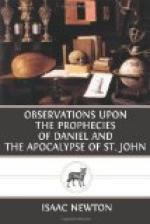After the death of Charles the great, his son and successor Ludovicus Pius, at the request of the Pope, [13] confirmed the donations of his grandfather and father to the see of Rome. And in the confirmation he names first Rome with its Duchy extending into Tuscany and Campania; then the Exarchate of Ravenna, with Pentapolis; and in the third place, the territories taken from the Lombards. These are his three conquests, and he was to hold them of the Emperor for the use of the Church sub integritate, entirely, without the Emperor’s medling therewith, or with the jurisdiction or power of the Pope therein, unless called thereto in certain cases. This ratification the Emperor Ludovicus made under an oath: and as the King of the Ostrogoths, for acknowledging that he held his kingdom of Italy of the Greek Emperor, stamped the effigies of the Emperor on one side of his coins and his own on the reverse; so the Pope made the like acknowledgment to the Western Emperor. For the Pope began now to coin money, and the coins of Rome are henceforward found with the heads of the Emperors, Charles, Ludovicus Pius, Lotharius, and their successors, on the one side, and the Pope’s inscription on the reverse, for many years.
Notes to Chap. VII.
[1] Chap. vii. 8.
[2] Ver. 20, 21.
[3] Ver. 24.
[4] Ver. 25.
[5] Sigonius de Regno Italiae, ad Ann. 726.
[6] Sigonius ib. ad Ann. 726, 752.
[7] Sigon. ib. Ann. 750.
[8] Sigon. ib. Ann. 753, 754, 755.
[9] Sigon. ib. Ann. 773.
[10] Sigon. de Regno Ital. ad Ann. 796.
[11] Vide Anastasium.
[12] Sigon. de Regno Ital.
[13] Confirmationem recitat Sigonius, lib. 4. de Regno Italiae, ad An. 817.
* * * * *
CHAP. VIII.
Of the power of the eleventh horn of Daniel_’s fourth Beast, to change times and laws_.




